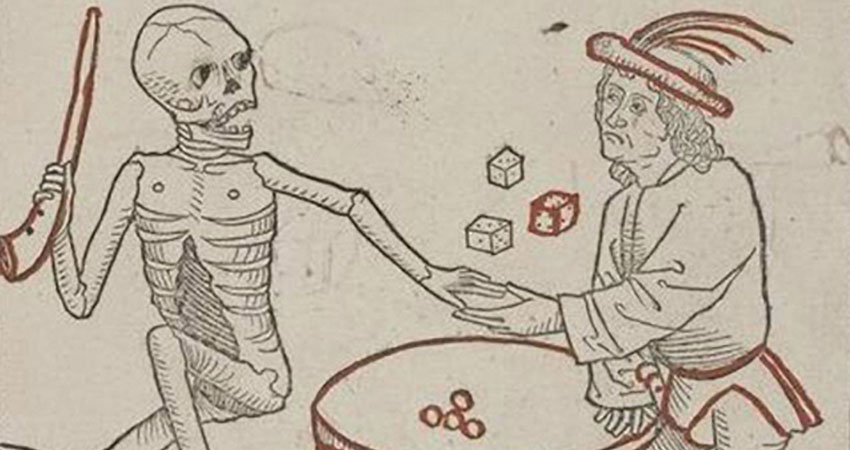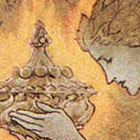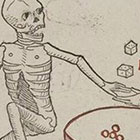
Flatline: Dealing with death
When the reaper comes for your players’ characters, will you stay his hand? Can you? Today, I’m talking about strategies for dealing with death in story-driven games to help you answer the question: What do you do when the scythe drops?
In action-oriented games, the threat of death is omnipresent. That means you (the mighty GM) and the shrouded one are practically kin. When the reaper comes for your players’ characters, will you stay his hand? Can you? Today, I’m talking about strategies for dealing with death in story-driven games to help you answer the question: What do you do when the scythe drops?
This article focuses on the aftermath of death, not how characters should and shouldn’t die, although that’s very important too. Before we move on, I’ll just say that the single most important thing to remember when a character is still just in danger of dying is that the death needs to be satisfying, or else the player will be grumpy—no matter how cool the aftermath is. JHKim has an excellent article about this facet of character death, and as usual, Vincent Baker gives the best advice: “Characters only get to die to make final statements.”
Enough of that. On to the main event: dealing with death when it does happen.
Below are a number of strategies for dealing with character death, with pros and cons for each. There are a number of ways to organize these strategies, but I choose to order them by how much they disrupt play for the dead character’s player. Here’s the list:
So many ways to die
- Player is out
- Player takes new role (GM assistant)
- Player reboots in his role (new character)
- Player continues role, with a twist
I don’t think any of these are better than any of the others; every game has different needs. You’ll probably want to be consistent though, so think careful before the characters start dropping.
Player is out
You only live once, and so does your character. This makes for high stakes play, which could split a couple different ways depending on the kinds of players you have and how attached they are to their characters. At one end, if the game is short (or long, but very close to the end), you’ll see brave players take more risks, because they know they won’t get another chance. At the other end, if the game is long or the players are particularly invested in their characters, the fear of death could drive them toward caution. That might be exactly what you want if your game is realistic, but it’ll crush the spirit of a pulp game to… a pulp.
Player takes a new role as GM assistant
The player’s character is dead, but the player still gets to participate in the game. He’s now something like a GM’s assistant. In general, you’ll want to pick one or two parts of your GM role and hand them over to the player. For example, have the widower-player take on the role of several important NPCs, direct the villain in battle, or add elements to the start of scenes to spice things up and make the game less predictable. Since the player’s sympathy probably resides with the other players’ characters, he’s likely to add helpful elements (thereby reducing any mechanical difficulties resulting from the party becoming smaller, in a combat-heavy game).
This solution can be a godsend for a busy GM, especially in a large game, but not every player takes to his new role as easily, and things can get cumbersome if your assistant doesn’t follow your lead. This strategy isn’t particularly sustainable, either; it’s unlikely you’ll keep the player happy in this role for more than a session. If character creation for your game takes a long time, you can use this as a temporary strategy, before jumping to the next one on the list. Alternatively, if you want a go as a normal player, maybe you can convince the widower-player to take on the GM roll instead!
Player reboots in his role with a new character
The player’s character is dead, but a new character comes along, and he looks trustworthy, so he joins the party. This is the standard solution for many games, and with good reason: It keeps the player in the game, and not only does it provide him an opportunity to try something new, but it also gives him a chance to shore up party weaknesses.
The downsides to this approach are well-known. The most immediate effect is that death can easily become much less meaningful unless the players put in the effort to actually roleplay their characters’ grief. Many times characterization just goes out the window, as you struggle to explain why a group of abnormally-suspicious characters should suddenly allow a stranger to join them.
Player continues in his role, with a twist
So the character died. Good thing Death Is Only The Beginning! Let the player continue to play his now-dead character as a ghost haunting the party, a lost spirit making his way back to the world of the living, or even just as a zombie. These options allow the character’s story to continue and make the setting more dynamic, if it’s done carefully, but they risk derailing the game if too much time is spent away from the main party. (If you think the journey home will be an epic one, consider doing it another time and using a different tactic for the remainder of the session.)
Alternatively, maybe the character can simply be resurrected. If that’s part of your setting, just don’t let it be dull: That character has been touched by death, and his caress is unforgettable. Consider giving the character new powers and weaknesses. Weakening a character is a tempting option to give death mechanical weight (especially in a combat-driven game), but keep in mind that weaker characters make life hard for the rest of the party. Roleplaying Tips offers some interesting ideas in this arena.
Change it up
While it’s good to settle on a default, one possibility is to leave it up to the players. If you’re following Vincent’s and JHKim’s advice, every death will be unique, so it makes sense for them to play out differently sometimes. Give some options, ask leading questions (“Kyra, why are you so sure you’ll see Rendar again?”), and above all, don’t rush through the death.
There’s a long tradition of murderous GMs who take the laughter out of slaughter, and of pacifist GMs who take death off the table entirely. I hope the tips above help you find your own way to walk with death. Got your own ideas? Let’s hear ‘em in the comments below!



